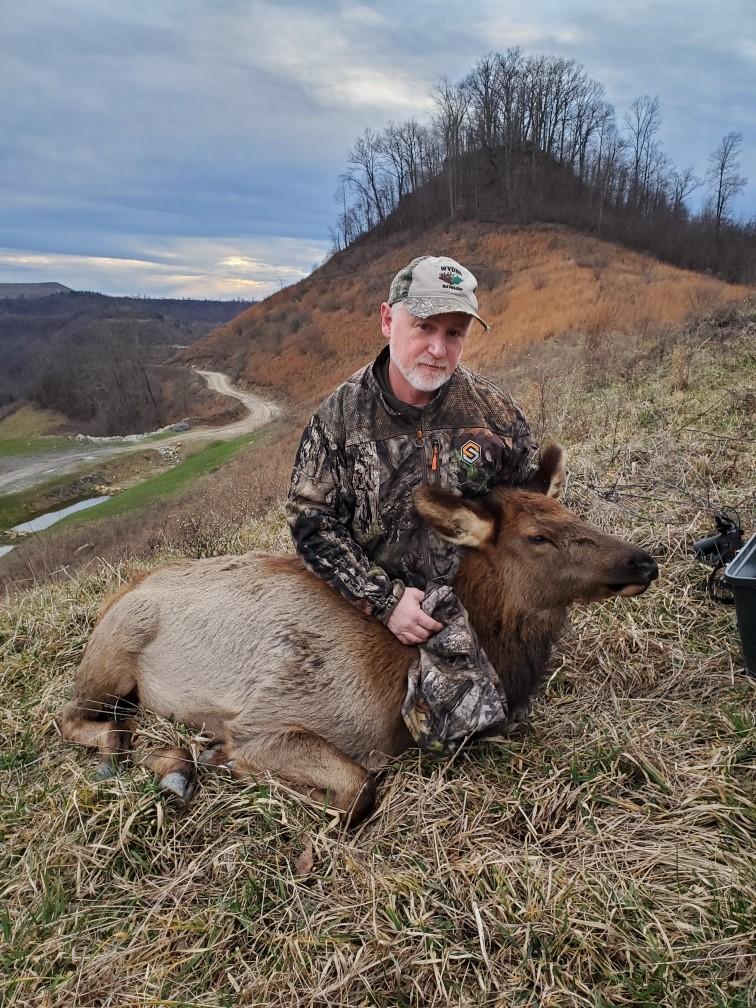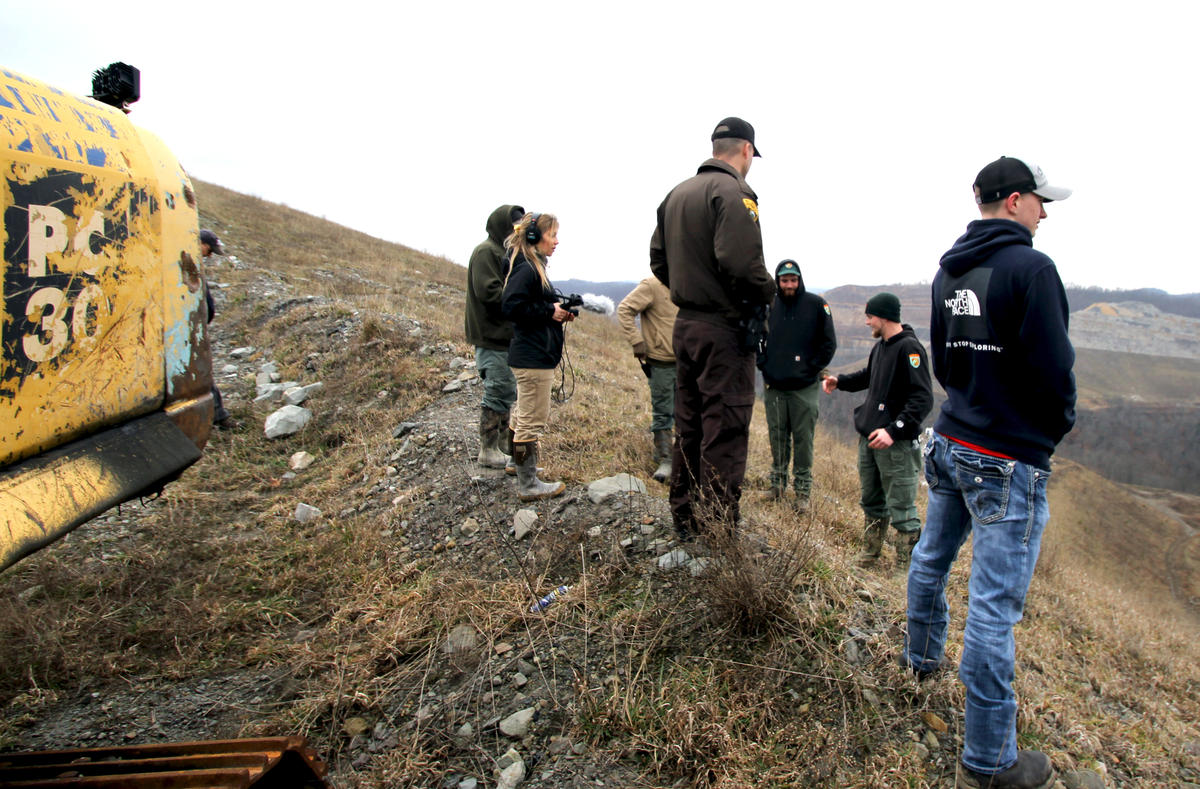Looking at West Virginia's Elk Herd Four Years In

By Caitlin Tan
March 16, 2020 - The West Virginia elk reintroduction program is four years in, and the project is not growing as fast as expected; however, there is a herd in the Southern Coalfields that is slowly getting bigger.
Much of West Virginia's elk reintroduction program is modeled after Kentucky’s, which is more than 20 years old. Officials there estimate the program provides a nearly $3 billion hunting and tourism boost to the economy. West Virginia’s Department of Natural Resources [DNR], who oversee the elk in the Mountain State project, hope to see it flourish in similar ways.

The DNR crew puts a radio collar on an elk several days after WVPB came to report. From left to right, Larry Harvey, Jake Wimmer, Logan Klingler, Hick Glotfelty, Kenny Wilson, Randy Kelley and Doyle Gore.
Photo: West Virginia Department of Natural Resources
Reclaimed Mines For Elk
West Virginia’s herd of about 80 elk live on the over 35,000-acre Tomblin and Laurel Lake Wildlife Management Area that is primarily reclaimed strip mines. It is in Logan and Mingo counties – in the heart of the state’s Southern Coalfields.
Randy Kelley, the DNR elk biologist and leader of the program, took WVPB on a tour of the area.
“There’s an elk right there. See? Over there,” Kelley said. “There you seen your first elk in West Virginia. You’ve not even gotten out of the truck yet.”
And to the left was one of the few active strip mines in this area.
Logan Klingler, the DNR wildlife manager, said the reclaimed land creates preferred elk habitat called early successional growth. He explained as an explosion went off.
“That’s an old mine blast,” Klingler said. “They’re blowing up rocks and they’re going to go mine it and put it back together and put grass on top of it.”
The mine reclamation process creates open areas with freshly seeded grass that are not heavily forested, something that West Virginia does not have much of naturally, but is beneficial to elk.

Elk project leader Randy Kelley with an elk the team tranquilized to put a radio collar and/or ear tags on. This was several days after WVPB came to report.
Photo: West Virginia Department of Natural Resources
The Elk “Hunt”
West Virginia’s elk herd was brought in from Kentucky and Arizona between 2016 and 2018, after several eastern states began reintroducing elk. Before the Civil War and prior to industrial development, elk were common in Appalachia. The rugged landscape was spotted with the 700-pound, light and dark brown creatures bugling during mating season in the fall.
As part of the project, the DNR team locate and shoot elk with tranquilizer guns to put GPS tracking collars on them. It is how they learn about how the elk are adjusting to West Virginia -- like where they are eating, drinking, bedding down and if they are staying off roads.
Kelley said he and the crew go out most days in the winter to put collars on elk that do not have them already, but they are wild animals. And sometimes, like on this day, there are no elk.
“Well we’re skunked for tonight,” Kelley said, on the day WVPB accompanied the team. “Sometimes you get the dog and sometimes the dog gets you. The dog got us tonight.”
Growing A Sustainable Herd
Four years into the project, the West Virginia elk herd is smaller than biologists had hoped it would be by now.
They received grants from organizations like The Conservation Fund, the Wildlife Restoration Program and the Rocky Mountain Elk Foundation with the goal of reintroducing elk to southern West Virginia during a five-year timespan. However, Kelley said other states are not willing to give up their elk right now, so West Virginia has seen no outside additions to the herd since 2018.
This pushes back one of the main goals of the project, which is to introduce an elk hunting season to West Virginia. Although, Kelley said he has high hopes for elk-related tourism, as there is already interest in tours of just the wildlife management area, without even a guarantee to see any elk. But with the state surrounded by successful, longer running elk reintroduction programs in Kentucky, Virginia, Pennsylvania and North Carolina, is it realistic to expect tourism numbers to soar in West Virginia?
Sara Cottingham, West Virginia-based community planner at Downstream Strategies who specializes in outdoor recreation planning, said maybe.
“I would not at all say that means West Virginia couldn’t be competitive, I think with targeted marketing and aggressive pushing it could really be a successful destination,” Cottingham said. “And I do think that adding elk tourism to that portfolio of what we have to offer would really enhance everything.”
Wild And Wonderful
And Kelley, the project leader, said there are more to it than just the economic benefits. It is restoring a species that was once native here, kind of adding to that magic of “wild and wonderful” West Virginia.
“I've seen elk on TV, I’ve been out West, I’ve driven through Yellowstone, but seeing an elk at home is a whole lot different, or hearing it bugle in your home state as it echoes through the hills of West Virginia, it's, you know, make the hairs on the back of your neck stand up,” he said.
As for the local community, Kelley said most are supportive.
John Burchett, a resident from Williamson said he is hopeful the program will help the West Virginia’s Southern Coalfields’ lagging economy.
“The post-coal economy is going to be kind of tourism based, and the more things we have to do, the more entertainment, more adventure tourism that we have, the better off we'll be. And the elk program is a big part of that," he said.
Disease Is Inevitable
Some local deer hunters have expressed concern about the ability of the elk to coexist with white tail deer, Jake Wimmer, the DNR elk technician, said. But he added that so far, the way the two animals use the land is different.
“Deer are browsers and elk are primarily grazers,” he said. “So your deer are going to be, you know, in the hardwoods during a nice mass drop year eating acorns, while your elk are still going to be out on the strips, on the plains and grazing the good grass.”

The DNR crew waits while elk project leader Randy Kelley attempts to tranquilize an elk several miles away.
Photo: Eric Douglas, West Virginia Public Broadcasting
However, the DNR recently reported a third of the elk from Arizona, about 15, perished due to the East Coast’s deadly brain worm disease, which white tail deer happen to be the host of.
The disease is caused by an infected snail or slug that animals can ingest from grazing that rarely affects deer, but typically will kill an elk. Researchers estimate about 10 percent of elk herds in the East fall victim to brain worm, albeit West Virginia is experiencing higher rates.
Kelley said it could be the stress the Arizona elk underwent traveling 33 hours cross country and adjusting to a new environment that lowered their immune systems.
Jeff Larkin, professor of wildlife ecology and conservation at Indiana University of Pennsylvania, worked with the Kentucky elk reintroduction program back in the late 90s. He said he saw higher rates of brain worm in the early years, too.
“You bring in 1,000 animals, and you lose 100. Yeah, it's 10 percent, but you still have 900 animals to reproduce and replace what's happening there, right? It's not like, great for the population. It's just that the population can withstand that,” Larkin said.
Moving Forward
But West Virginia’s elk population is still relatively small, around 80, and every disease and death means the herd could be less resilient in the years to come. Growing those numbers, without bringing in more elk from out West, takes time. In Pennsylvania, for example, 177 elk were reintroduced in the early 1900s, and about 100 years later the herd is thriving at around 1000
And while the West Virginia biologists hope that it will not take that long to grow the state's herd, they admit that the project is a little behind in their initial goal to reach 150 elk by the end of 2020.
But in the meantime, they are maintaining the herd they do have, plus, Kelley said he expects West Virginia-born elk calves this spring.
This story is part of West Virginia Public Broadcasting’s Southern Coalfields Reporting Project which is supported by a grant from the National Coal Heritage Area Authority.

